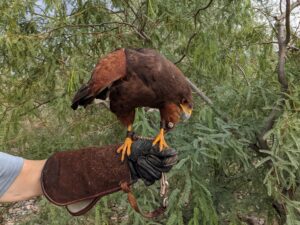Harris’s Hawk – Lance
 Name: Lance – male
Name: Lance – male
Species: Harris’ Hawk
Liberty Arrival: 2004/Nestling
Injury/Condition: Leg injury and Trichomoniasis disease
Arriving as a nestling, Lance was found to have both a leg injury and Trichomoniasis, a disease caused by a protozoan that can kill a bird if left untreated. While Lance was being treated for the disease, the tendon in his injured leg slipped from its location, requiring additional surgery. After recovering from both the surgery and the Trichomoniasis, Lance again became sick with that disease requiring further treatment. As a result of his extended stay in the intensive care unit of Liberty’s medical facility, Lance became imprinted.
Harris’ Hawk Facts
Also known as the “Wolves of the Sky”, Harris’s hawks can be found in the southwestern United States (Arizona, New Mexico, and Texas) through Central America and into the drier parts of South America. In Arizona, its range typically extends only as far north as Wickenburg. The Harris’ hawk is one of only two hawks known to hunt in a cooperative group manner (The Galapagos hawk is the other). It displays one of the most advanced group hunting tactics among birds.
Life span: The average life expectancy of the Harris’ hawk has been estimated to be up to 12 years in the wild and twice as long in captivity.
Prey: The majority of its prey consists of mammals such as cottontail rabbits, jackrabbits, rats, ground squirrels, gophers. Their diet is also supplemented by birds, primarily Gambel’s quail, and reptiles.
Babies/Nests: Nests of sticks and other materials are built in or on top of solid structures such as trees, saguaros, electric or telephone poles. The female usually lays 3 to 4 eggs and incubation lasts between 31 and 36 days. The young fledge in about 40 days.
Halcón de Harris – Lance
Nombre: Lance – Macho
Especie: Halcón de Harris
Llegada a Liberty: 2004 / pollito
Herida/Condición: Herida de pierna y enfermedad de Trichomoniasis
Llegando como un pollito, Lance se encontró con una pierna herida y Trichomoniasis, una enfermedad causada por un protozoario que puede matar a un pájaro si no se hace el tratamiento adecuado. Mientras que Lance estaba siendo tratado por la enfermedad, el tendón en su pierna herida se resbalo de donde estaba y requiero mas cirugía. Despues de que se recupero de la cirugía y Trichomoniasis, Lance se enfermo nuevamente. Como resultado de su estancia larga en el UCI de Liberty Wildlife, Lance se imprento.
Datos del Halcón de Harris
Descripción: También conocidas como los “lobos del cielo”, el Halcón de Harris puede ser encontrado en el sur oeste de los Estados Unidos (Arizona, New Mexico, y Texas) a través de Centroamérica y en las partes mas secas de Sudamérica. En Arizona su rango típicamente se extiende hasta el Norte en Wickerburg. El Halcón de Harris es uno de los dos tipos de halcones conocidos por cazar en grupo cooperativo.
Duración de vida: La esperanza de vida del Halcón de Harris fue estimado poder llegar hasta los 12 años en el estado salvaje y en cautiverio pueden sobrevivir has lo doble.
Presa: La mayoría de su presa consiste en mamíferos como los conejos de cola de algodón, liebres, ratas, ardillas, y tuzas. Su dieta también es suplementada por pájaros, como la codorniz de gambel, y reptiles.
Nidos: Sus nidos consisten en palos y otros materiales, son construidos a dentro o encima de estructuras firmes como los arboles, saguaros, o postes de electricidad o de teléfono.
Crías: La hembra pone 3 a 4 huevos y la incubación dura entre 31 y 36 días. Después de aproximadamente 40 días, los jóvenes se van del nido.


